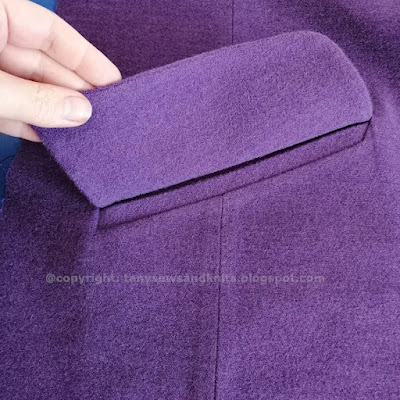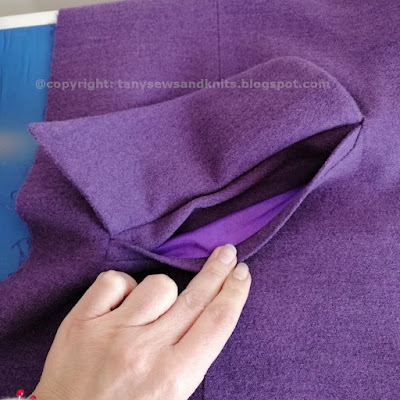EN Summary: Today I'm sharing some details of my current project: a double-breated purple overcoat. Keep reading the full article on tanysewsandknits.blogspot.com.
---
PT Sumário: Hoje vou partilhar alguns detalhes da confeção do meu projeto de costura atual: um sobretudo assertoado roxo. Continuem a ler o artigo completo em tanysewsandknits.blogspot.com.
EN: I'm using another pattern from the 3/95 Burda International magazine, one that I've sewn before in my twenties; my first version was made of camel brushed wool and had a golden satin lining. This time around I'm using this double-faced coating which has a crepe-like structure on one side and is brushed on the other side. The crepe face is supposed to be the right side but I kind of liked the brushed side's texture and shade better. The fabric's composition is 64% viscose and 36% wool and it has a fair amount of body, without being too heavyweight. It is also very stable, perhaps due to the crepe-like surface acting as a stabilizer layer. I purchased this fabric online from Fabrics4Fashion, a Portuguese textile retailer.
---
PT: Estou a usar mais um molde da revista Burda Internacional 3/95, um sobretudo que já tinha confecionado há muitos anos feito de veludo de lã camel com um forro de cetim dourado. Desta vez estou a usar um tecido para sobretudos com duas faces, uma com uma textura tipo crepe e outr acom textura escovada. A face em crepe supostamente é o direito do tecido, mas gostei mais da textura e da cor da face escovada, por isso é essa que estou a usar. O tecido tem uma composição de 64% viscose e 36% lã, e tem bastante corpo (embora não seja demasiado grosso). É também bastante estável, talvez graças à face em crepe. O tecido foi comprado online em Fabrics4Fashion, um fornecedor textil Português.
EN: I've made some interfacing tests with this fabric and came to realize that it doesn't need much additional structure so I didn't interface the front of the coat entirely as suggested, and instead interfaced just the front facings, upper and under collar, shoulder/armhole areas, front lapels, hem allowances and vent facings (sleeves and center back). I've also applied interfacing on the buttonholes and pockets placement areas. The coat will be quite oversized and I didn't want it to feel too "stiff", but rather structured on the shoulders alone.
As it can be seen in the main photo, the buttons are quite thick and I don't think machine-embroiderd buttonholes would work well in this case, because the sizing of the buttonhole is determined only by the button's diameter (which is large already in this case), so I opted for bound buttonholes instead and used the method so expertly described by Paco Peralta in his article "Ojal Ribeteado - Bound Buttonhole".
---PT: Fiz alguns testes com entretelas neste tecido e cheguei à conclusão que não precisa de tanta estrutura adicional como outros tecidos de lã, então não entretelei as frentes por completo como sugerido nas instruções, entretelando apenas as vistas da frente, a área dos ombros e das cavas, lapeças na frente, margens de bainha e vistas das aberturas/rachas (mangas e centro atrás). Nas frentes também reforcei a área das casas de botão e dos bolsos. O casaco será bastante largo e quis que tivesse uma boa estrutura nos ombros mas que no corpo mantivesse um caimento mais fluído.
Como se pode observar na primeira foto deste artigo, os botões são bastante espessos e neste caso as casas bordadas com a máquina de costura no automático não costumam resultar bem porque apenas tomam em consideração o diâmetro do botão, e mesmo esse não pode ser demasiado grande. Optei então por confecionar casas avivadas, e usei o método ilustrado com maestria pelo Paco Peralta no seu artigo "Ojal Ribeteado - Bound Buttonhole".
EN: Another technical detail featured by this overcoat is the slanted pockets with large flaps. The pockets are placed between the front and side panels so after sewing the bound buttonholes on the right front I stitched the fronts to the side panels, and fused a rectangle of interfacing on the pocket placement area. I used my usual method to sew this type of pockets, which involves precise cutting of all the pocket pieces and very precise stitching. I'm not explaining it in detail this time but I'm showing the final result:
---
PT: Outro detalhe técnico que este sobretudo tem é os bolsos inclinados com paletas largas. Os bolsos ficam posicionados na junção das frentes com os painéis laterais, por isso depois de terminar as casas avivadas na frente direita, prossegui a unir os painéis laterais com as frentes e a reforçar com um retângulo de entretela termo-colante a área onde se posicionam os bolsos. Usei o método que costumo usar, que implica cortar todas as partes com precisão e cosê-las com igual precisão. Não vou explicar esse método outra vez, vou apenas mostrar o resultado:
EN: The flap is shaped to match the slope of the pocket and the minimal style of the overcoat. Under the flap there's one single 5/8" wide welt.
---
PT: A forma da paleta condiz com a inclinação do bolso e com o estilo minimalista do sobretudo. Debaixo da paleta esconde-se uma única pestana com 1,5cm de altura.
EN: The pocket bag that faces the coat is cut of lining while the back pocket bag is cut of fashion fabric (because the latter may become visible when the hands are in the pockets).
---
PT: A fundura que fica atrás é cortada de tecido (pode ver-se quando metemos as mãos nos bolsos) enquanto a outra é cortada de forro.
EN: Finally here's how the pockets look on the wrong side; since the overcoat will be fully lined, the pocket bag allowances can be left raw or pinked to prevent fraying:
---
PT: Finalmente é assim que os bolsos ficam por dentro; uma vez que o sobretudo será forrado, o acabamento das funduras pode deixar-se a fio ou, em alternativa, aparado com a tesoura zigue-zague para evitar que desfie:
EN: I will resume the construction of this overcoat next weekend. Until then be safe and thanks for dropping by!
---
PT: Vou retomar a confeção deste casaco no próximo fim-de-semana. Até lá mantenham-se seguros e obrigada por aparecerem!













6 comments:
Great color. I love purple. Can you post a line drawing of the coat pattern?
Thanks, Kathy. I will post the line drawing in my next post😊
Beautiful work as always Tany! The color and fabric are wonderful.
Tany, always I’m so impressed with your style, precision and beauty of your garments. Do you teach. Boy would i love to take a class from you. I made a purple coat a couple of years ago. I was very proud as i got a lot of compliments but learning is always my first priority. Thank you for sharing.
So beautiful and such precise work.
Thank you all for the lovely comments!
Anascana: Thank you so much! I do not teach "per se",... I'm not a professional, sewing is just a hobby :) that I've been keeping for most of my life. I have a full time job in Electronic Engineering so I sew in my spare time. I share what I know and learn about sewing here in this blog :).
Post a Comment